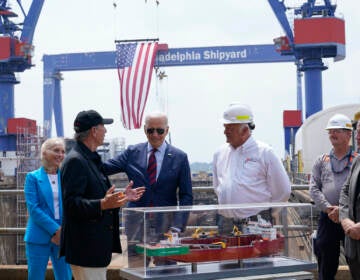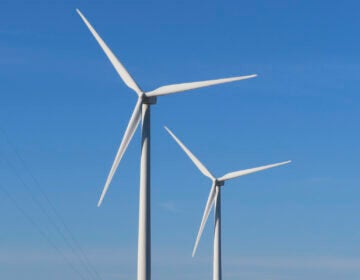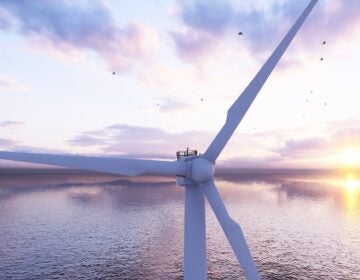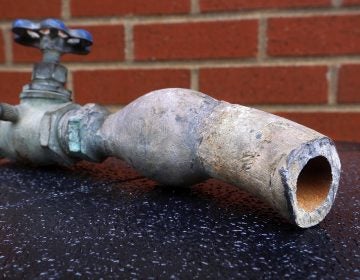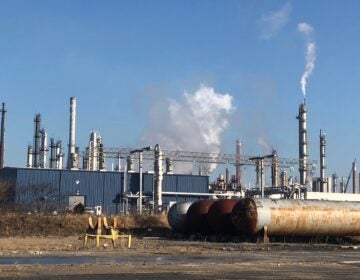How a Trump victory could stall offshore wind expansion
Trump said he would stop offshore wind on “day one” should he win the election. The wind industry worries about delays to permits and proponents worry about jobs.
Listen 5:56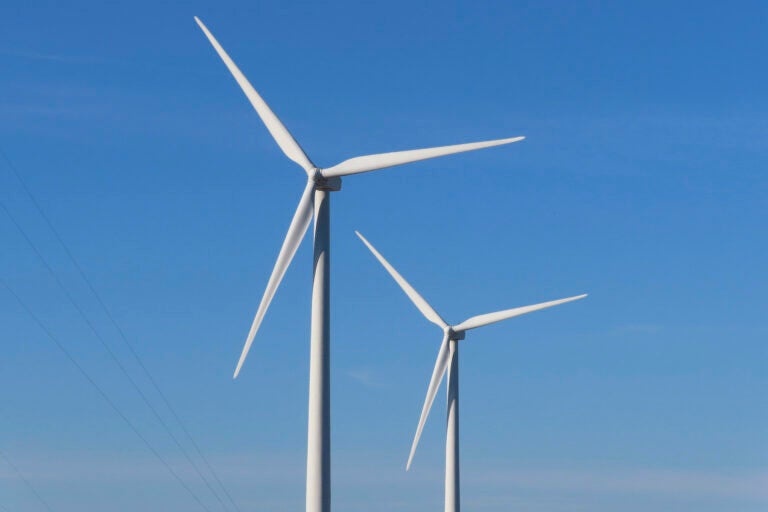
FILE - Land-based wind turbines spin in Atlantic City. N.J. on Nov. 3, 2023. (AP Photo/Wayne Parry, File)
What questions do you have about the 2024 elections? What major issues do you want candidates to address? Let us know.
At a rally in Wildwood, New Jersey in May, former President Donald Trump told a cheering crowd how he feels about offshore wind.
“They destroy everything, they’re horrible and they’re the most expensive energy there is,” he said. “They ruin the environment, they kill the birds, they kill the whales!”
Scientists say the whales are not killed by offshore wind development, but by ship strikes and entanglement in fishing gear. Still, research is ongoing and there’s a lot of opposition to offshore wind down the shore, where residents worry not just about whales but about the impact on tourism and the ocean’s ecosystem. Evidence shows the fishing industry has reason to fear it will impact their catch.
So while stumping at the shore, Trump made his supporters a promise.
“We are going to make sure that that ends on day one,” said Trump. “I’m going to write it out on an executive order, it’s gonna end on day one.”
While Trump cannot just eliminate an entire industry with a stroke of his pen, he could delay new projects and reverse course on one of President Joe Biden’s signature climate initiatives.
Biden, along with Vice President Kamala Harris, set a goal of installing 30 gigawatts of offshore wind energy by 2030, enough to power 10 million homes.
And that has the industry worried enough to start fundraising for Harris. A report published in May by Wood Mackenzie says a Trump presidency could halt $1 trillion of investments in clean energy.
“So a Trump presidency would have a negative impact on the offshore wind industry,” said Tim Fox, an industry analyst at the nonpartisan, Washington-based Clearview Energy Partners. “The question is to what degree?”
Hitting the pause button on offshore wind
Fox said one way Trump could hit the pause button on offshore wind would be to simply refocus the efforts of the Bureau of Ocean Energy Management, the federal agency in charge of siting and permitting, away from offshore wind and toward more oil and gas leases.
“Under this scenario, project reviews would very likely slow, and uncompleted lease sales may not occur. But the lease sales and the project reviews that are already completed under the Biden administration would likely be safe,” Fox said.
Two small offshore wind farms exist along the East Coast, including the Block Island Wind Farm off the coast of Rhode Island and the Coastal Virginia Offshore Wind pilot project. The recently completed South Fork project off the coast of Long Island, New York is the nation’s first commercial-scale offshore wind farm. Three more are under construction, including Vineyard Wind, Ørsted’s Revolution Wind and Dominion Energy’s expanded Coastal Virginia Wind project. They are likely to move forward no matter who takes the White House in January.
But Fox said the other way to block pending offshore wind projects would be through the Justice Department.
Offshore wind opponents have filed lawsuits challenging federal permits.
Trump could instruct the department to simply not defend these cases.
As a result, Fox says the Biden administration is fast-tracking permits, hoping to complete the process before Inauguration Day on Jan. 20.
“We’ve noticed the tempo in which it is reviewing projects is speeding up,” he said.
Earlier this month, the agency gave the final approvals to construct Atlantic Shores South, a 200-turbine project off the coast of Atlantic City.
Fox said the states where offshore wind projects are planned are also worried and moving to speed up the regulatory process.
States driving development
When asked about the impact of a Trump win, a spokesperson for New Jersey Gov. Phil Murphy’s administration said in a statement that the state, “… is committed to a strong and thriving offshore wind industry in the years and decades to come to capture the lasting economic, workforce, and environmental benefits it brings to our state.”
But Kris Ohleth, director of the Special Initiative on Offshore Wind, a think tank that provides assistance to states like New Jersey and Delaware, said she’s been working on contingency plans.
“The states are the ones who are driving a lot of the infrastructure development, sometimes through federal funding, but also through state programs,” said Ohleth. “They’re building ports. They are building vessels.”
New Jersey has invested in making the state the offshore wind “hub” of the East Coast, spending more than $637.7 million dollars to build the country’s first offshore wind port along the Delaware Bay in Salem County.
Ohleth said while offshore wind is vulnerable to a change at the top, after 23 years in the industry she remains optimistic.
“If you take a step back and look at the totality of where offshore wind has been and where we are now, it’s a tremendous success,” she said. “So we’ve made great progress. The momentum is here that we didn’t have 10 years ago. So I have real faith in where we can go with this industry, regardless of who is in the highest office.”
Aesthetics or environment?
Both Fox and Ohleth said Trump’s opposition to offshore wind seems to be more about aesthetics than the environment. Trump lost a bid to block an offshore wind farm in Scotland, which he said ruined the view from his golf course.
Project 2025, the 900-plus page far-right playbook published by the Heritage Foundation and written by Trump administration officials, refers to offshore wind energy as “eyesore windmills built at taxpayer expense.” Although Trump publicly disavowed Project 2025, it is largely thought to be a potential policy plan for his administration should he be elected.
Under Project 2025, Biden’s goal of 30 gigawatts of offshore wind power by 2030 would be abandoned, because, as the publication states, offshore wind is “being used to advance an agenda to close vast areas of the ocean to commercial activities, including fishing, while rapidly advancing offshore wind energy development to the detriment of fisheries and other existing ocean-based industries.”
Ohleth said while Trump was in office, the fishing industry had his ear, while Biden and Harris are more swayed by environmentalists and labor, which stands to gain from offshore wind.
The ‘next generation of jobs’
Back in 2010, former Democratic state Sen. Steve Sweeney spearheaded New Jersey’s original offshore wind legislation.
“The reason why we did offshore wind was for the environment, but it was also for the manufacturing,” said Sweeney. “We wanted this to be an American industry, not an industry where the Europeans just send everything over to us and we install.”
At the time, there was bipartisan support for offshore wind. Then Republican Gov. Chris Christie signed the legislation. But Sweeney said it’s now become a partisan issue.
Sweeney, a union ironworker, said a pause in offshore wind could impact hundreds of union jobs.
While the New Jersey wind port will have plenty of business no matter what Trump does should he win, Sweeney said, the state has also invested $164 million dollars in EEW’s manufacturing plant in Paulsboro. The plant produces monopiles, the massive poles that support the wind turbines.
“We’re talking about the next generation of jobs, how we’re going to clean things up and we’re going to create good middle class jobs,” said Sweeney. “Just by saying on day one … shut it all down, people who are thinking about making hundreds of thousands of investments, obviously, they aren’t going to make them until they see the outcome of the election.”
In September, Delaware passed legislation to jumpstart offshore wind, which was pushed by Democratic state Sen. Stephanie Hansen.
“We have renewable energy goals that are important,” said Hansen. “They’re important for health reasons, for climate reasons, for environmental reasons … Plus, we’ve already begun the process of educating and building an [offshore wind] workforce. We are trying to repurpose areas that before have been traditional fossil fuel jobs. So we’ve already started this process. It would be a real shame to lose all of this momentum.”
Despite Trump’s opposition to offshore wind, and his support of increased drilling for oil and gas, Hansen pointed out that fossil fuel companies are some of the largest investors in offshore wind, including New Jersey’s Atlantic Shores project, which is backed by Shell.
“I don’t think that going backwards is something that even the fossil fuel industry honestly believes is the best path … because they’re already investing in offshore wind and other renewables because they see that’s the future. And it is the future.”
Trump’s words in Wildwood, however, may have already had an impact ahead of the election. A recent auction for leases off the coast of Delaware, Maryland and Virginia went for $750 an acre. Two years ago, a similar auction off the coast of New York and New Jersey fetched $11,000 per acre.

Get daily updates from WHYY News!
WHYY is your source for fact-based, in-depth journalism and information. As a nonprofit organization, we rely on financial support from readers like you. Please give today.



